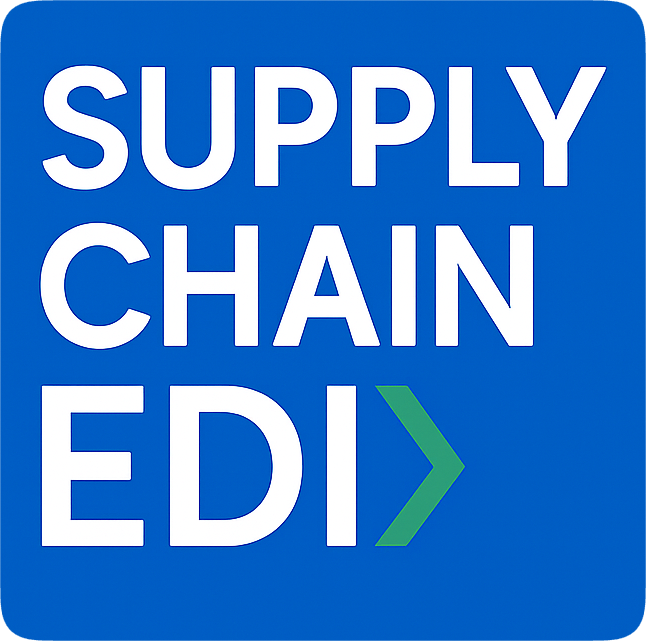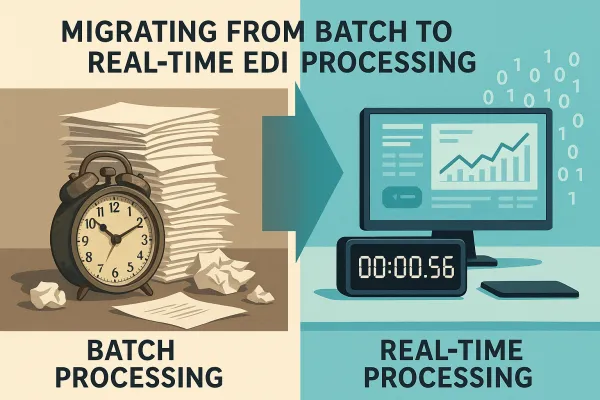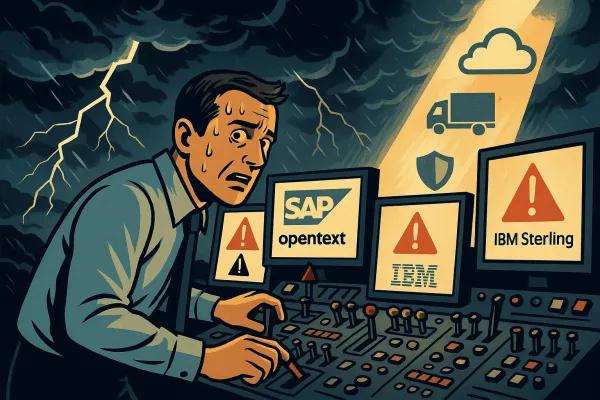The IoT-EDI Integration Implementation Guide: How to Automate Real-Time Supply Chain Data Exchange Using Sensor-Triggered Transactions in 2025

IoT-enabled EDI integration is driving one of the most significant advances in modern manufacturing, transforming how supply chain professionals automate data exchange between sensors and business partners. Instead of manually creating EDI documents when shipments arrive or inventory changes, sensors automatically generate EDI papers like Advance Shipping Notices (ASNs) or proof of delivery based on real-world events detected by connected devices.
This isn't just another digital transformation buzzword. A recent industry report projects that the global supply chain automation industry will be worth $17.5B globally by 2028, driven by AI, IoT, and hyperautomation advancements. The combination of IoT sensors with traditional EDI protocols creates automated workflows that eliminate the lag time between physical events and electronic documentation.
Understanding IoT-Enabled EDI Integration: Beyond Traditional Data Exchange
At its core, IoT-enabled EDI integration refers to the automated, secure, and standardized exchange of business documents—triggered, enriched, and validated using real-time data captured from your physical manufacturing assets (machines, sensors, inventory trackers, and more). This approach moves far beyond traditional batch processing where EDI transactions happen on predetermined schedules, regardless of actual business events.
Here's how it works differently: Traditional EDI waits for human input to trigger document creation. A warehouse worker scans a barcode, enters data into an ERP system, and then an 856 Advance Ship Notice gets generated hours later. With IoT-EDI integration, smart sensors monitor temperature, humidity, and security conditions in real-time, improving shipment visibility and security while automatically triggering the corresponding EDI documents the moment conditions change or thresholds are met.
The benefits compound quickly. This tight connection eliminates manual entry and legacy delays, so your ERP, warehouse, and trading partners receive up-to-the-second data, not batch-processed lag. Your 214 Transportation Carrier Shipment Status Messages update automatically when GPS sensors detect a delivery truck arriving at a destination. Your 846 Inventory Inquiry/Advice documents reflect actual stock levels detected by RFID readers, not yesterday's manual counts.
The Technology Stack: IoT Sensors, EDI Standards, and Integration Platforms
The sensor hardware landscape has matured significantly. Temperature sensing RFID tags are specialized radio-frequency identification tags equipped with temperature monitoring capabilities, designed to track and monitor temperature-sensitive products and assets throughout the supply chain. Modern implementations use various sensor types:
- Temperature sensors: Durable, flexible passive temperature sensor tags that work using standard UHF frequencies (915/868 MHz) can be affixed or embedded into most materials and have an average read range of 15-22 feet
- GPS tracking devices: Continuously report location data that can trigger 214 shipment status updates when vehicles enter or exit geofenced areas
- RFID inventory sensors: A single RFID Reader is powerful enough to process 140 events per second, or 1,400 sensors monitored simultaneously, and can achieve a read range of up to 300 feet
- Motion and vibration detectors: Alert systems when equipment failures occur or unauthorized movement happens
These sensors feed data into integration platforms that support both traditional EDI standards (X12, EDIFACT, TRADACOMS) and modern APIs. The integration layer handles the translation between sensor data formats and standardized EDI documents, ensuring your trading partners receive information in the formats they expect.
Pre-Implementation Assessment: Identifying IoT-EDI Integration Opportunities
Start by auditing your current supply chain visibility gaps. Where do you lose track of inventory, shipments, or production status between the time something happens physically and when you can report it electronically to trading partners?
The most common opportunities include:
- Warehouse operations: RFID sensors can automatically trigger 846 Inventory Reports when stock levels change, eliminating daily manual counts
- Transportation management: GPS and temperature sensors in vehicles can update 214 Shipment Status messages in real-time. This is where solutions like Cargoson, along with platforms like MercuryGate and Descartes, are integrating IoT data directly into their TMS workflows
- Production floors: Machine sensors can trigger production status EDI updates, alerting downstream partners about delays or completions without manual intervention
ROI calculations should factor both cost savings (reduced manual labor, fewer errors) and revenue protection (prevented stockouts, faster issue resolution). The integration of IoT and EDI offers the necessary information flow in real time hence enabling organizations make the right strategic decisions on routing, scheduling and resource control.
Critical Success Factors and Common Pitfalls
Before automating, verify your sensor accuracy and data mappings—bad data in means chaos out. This is the most critical piece many implementations overlook. If your temperature sensors drift by 2 degrees or your RFID readers miss 15% of tags, automating EDI based on this data creates more problems than it solves.
Trading partner readiness varies significantly. Some large retailers and manufacturers have sophisticated EDI systems that can handle sensor-enriched data fields. Others use basic EDI setups that break when they receive unexpected data elements. Test thoroughly before going live.
EDI is not designed to handle more sophisticated events from new kinds of "users" like IoT sensors or a digital camera noticing a damaged part received on the factory floor and triggering a notification. You'll often need middleware to translate between IoT events and standard EDI document formats.
Step-by-Step Implementation Framework for IoT-EDI Integration
Break your implementation into phases to manage risk and prove value quickly:
Phase 1: Sensor Deployment and Data Validation Start with a single use case like temperature monitoring in cold storage. Deploy sensors, validate data accuracy over 2-4 weeks, and establish baseline performance metrics. Don't move to Phase 2 until sensor data is consistently reliable.
Phase 2: EDI Mapping for Sensor-Enriched Transactions Configure your EDI system to incorporate sensor data into standard documents. For example, enhance 856 ASN documents with temperature readings from shipment sensors, or add real-time location data to 214 status messages. With the use of RFID technology, use the temperature loggers and supplementary RFID handhelds and fixed readers to capture historical and current temperature data. Take action on any discrepancies right away and ensure that product travels safely throughout a supply chain.
Phase 3: Automated Workflow Configuration Set up rules that automatically generate EDI documents when sensor thresholds are met. Configure exception handling for sensor failures, network outages, or data quality issues. This phase typically requires the most technical work.
Phase 4: Trading Partner Testing and Certification Test with key trading partners in a sandbox environment first. Some partners require certification testing when you change EDI document content or timing. Plan 4-6 weeks for this phase.
Technical Architecture: Connecting Sensors to EDI Workflows
Your integration architecture needs to handle both real-time sensor data streams and traditional EDI batch processing. IoT enables the collection and merging of sensor data with business systems. This technology provides you and your teams with real-time insights and bolsters the accuracy of your decision-making.
Most successful implementations use a middleware approach:
- Sensors send data to an IoT platform (AWS IoT, Azure IoT, or specialized platforms)
- The IoT platform processes and validates sensor data, applying business rules
- Validated sensor events trigger API calls to your EDI system or ERP
- The EDI system generates standard documents (856, 846, 214) enriched with sensor data
- Documents are transmitted to trading partners via traditional EDI channels (VAN, AS2, etc.)
Your IoT-EDI solution should plug seamlessly into your ERP (NetSuite, Infor, Visual, SAP, Oracle, etc.) and not require rework for each trading partner. This integration approach preserves your existing EDI relationships while adding real-time capabilities.
Industry-Specific Use Cases and Implementation Examples
Manufacturing: Machine Sensors Triggering Production Status EDI Updates Automotive suppliers use machine sensors to automatically generate 862 Shipping Schedule documents when production runs complete. Instead of waiting for daily batch updates, OEMs receive immediate notification when parts are ready for pickup.
Warehousing: RFID Inventory Sensors Automating 846 Inventory Reports EDI is the kind of IoT-connected smart shelves or warehouses where its inventory information is shared in order to avoid annual stockout or overstock conditions. Distribution centers use RFID sensors to track inventory movement in real-time, automatically generating 846 documents when stock levels change. This eliminates daily cycle counts and reduces stockout risk.
Transportation: GPS + Temperature Sensors Enriching 214 Shipment Status Messages Pharmaceutical distributors use combined GPS and temperature sensors to enhance 214 messages with location and cold chain compliance data. Temperature sensing RFID tags are extensively used in the food and pharmaceutical industries to monitor and ensure the integrity of products throughout the cold chain, from production to storage and distribution, helping monitor the temperature of pharmaceutical products during storage and transportation. Freight management platforms like Cargoson, FreightPOP, and 3Gtms are building these capabilities into their core offerings.
One concrete example: BOLD VAN sees transforming the daily operations, cost structures, and competitive positions of SMB manufacturing clients every day through IoT-EDI implementations that deliver measurable results in weeks, not months.
Measuring Success: KPIs and Performance Monitoring
Track these metrics to validate your implementation:
- Transaction Processing Speed: Measure time from sensor event to EDI document transmission. Target sub-15 minute processing for critical documents
- Data Accuracy: Compare sensor-generated EDI documents to manual versions. Aim for 99.5% accuracy or better
- Exception Handling: Monitor sensor failure rates, network outages, and data quality issues. Automated systems should maintain 99.9% uptime
- Trading Partner Satisfaction: Survey partners on data timeliness and accuracy improvements
These devices cause automatic notifications of occurrence of events such as delays, damage or even equipment failure, which are likely to take less time to deal with. The integration of IoT and EDI offers the necessary information flow in real time hence enabling organizations make the right strategic decisions on routing, scheduling and resource control.
Advanced Scenarios: AI-Powered IoT-EDI Optimization
The next evolution combines AI with IoT-EDI integration for predictive capabilities. Machine learning models analyze historical EDI data patterns alongside real-time sensor feeds to predict and prevent supply chain disruptions.
For example, predictive maintenance algorithms can analyze temperature, vibration, and operational sensor data to identify equipment that's likely to fail. Instead of waiting for actual failure, the system can automatically generate maintenance requests and update production schedules via EDI before disruptions occur.
If an IoT-enabled exception event is detected in near real-time and logged to a blockchain, the manufacturer can proactively initiate a recovery process, such as a re-shipment of the affected product, thereby possibly eliminating the need to undertake the "late stage" chargeback process.
Multi-carrier shipping platforms are integrating these capabilities too. Solutions like Cargoson, alongside ShipStation and Sendcloud, are building AI models that use sensor data and EDI transaction history to optimize routing and prevent service failures.
Future-Proofing Your IoT-EDI Integration Strategy
Digital transformation, automation, and the growing requirement for real-time data interchange are all having a big impact on the future of EDI. New businesses are moving away from batch-based EDI and toward real-time API-based EDI architectures.
The integration of blockchain technology with IoT-EDI systems is emerging as a way to ensure data integrity and create immutable audit trails. Blockchain in EDI is a technology that is being utilized to help people trust EDI transactions. It keeps an unchangeable record of all data exchanges, which lowers the risk of fraud, ensures compliance, and automates procedures that involve more than one party.
5G networks will enable more sophisticated sensor deployments with higher data throughput and lower latency. Edge computing will allow more processing to happen locally, reducing dependence on cloud connectivity for time-critical EDI generation.
EDI is alive and well and will remain critical to business for many years to come. However, the true future lies in using and evolving B2B integration alongside disruptive technologies such as IoT, blockchain and AI, to deliver innovative levels of multi-party supply chain collaboration.
Transportation management platforms like Cargoson, Transporeon, and Oracle TM are already building these next-generation capabilities into their core platforms. The key is choosing integration partners who understand both legacy EDI requirements and emerging technology trends.
Start with one use case, prove the value, then expand systematically. The combination of IoT sensors and EDI automation isn't just about efficiency—it's about building supply chain resilience that adapts to disruptions in real-time.





